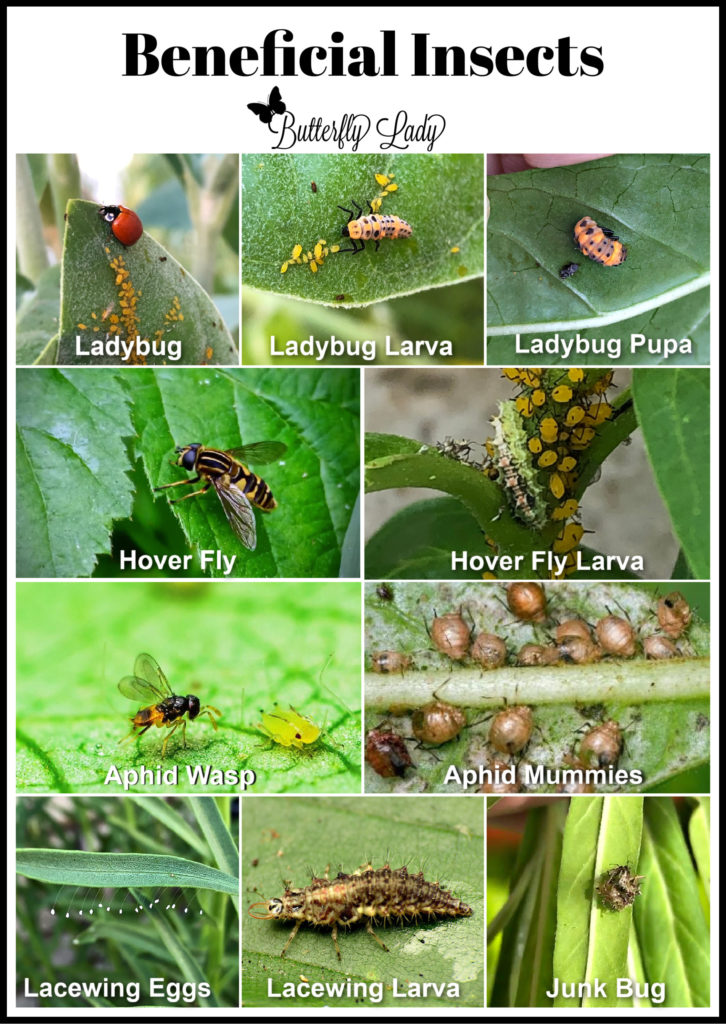If you grow milkweed, you will most likely have aphids. I constantly get asked, “How do I get rid of the aphids on my milkweed?”

Oleander Aphids are a non-native insect and they can multiply very quickly. However, they are not a direct threat to monarch caterpillars because they feed on the milkweed plant only. They can indirectly affect caterpillar health by depleting nutrients in their only host plant. They tend to be problematic when the plant is very small or weak. Aphids suck sap from the plant tissues, and if populations are high, can stress plants and kill small or young plants.
Heavily infested milkweed can be stunted or deformed, and black sooty mold grows on the large amounts of sticky honeydew produced by the aphids. When aphids or other sap sucking insects suck sap from a plant, the plant is weakened and there is a risk of the insect infecting the plant with disease. It sometimes spreads plant viruses from one plant to another.

I do not recommend using insecticides to control aphids because it will kill much more than the aphids and most likely your monarch larvae as well. Even if the insecticide is labeled organic, that doesn’t mean it’s safe for caterpillars. Using systemic insecticides to get rid of aphids can be much more harmful to the monarch caterpillars than the aphids themselves. Some people recommend using neem oil but the oil tends to stay on the leaf. Neem oil can also be systemic. One label states that “neem oil does not harm beneficial insects, only sucking and chewing insects”. Caterpillars are chewing insects.
Here are some recommended strategies to help control the aphids population on milkweed:
- If there is enough milkweed for caterpillars, cut off any part of the plant that is infected with aphids and dispose of the stems in a sealed bag.
- Although time-consuming, the safest way to remove aphids is manually by squishing them between your fingers (you can use gloves to avoid staining your fingers) and then using a hose to dislodge them from the plant. I use this method with young milkweed plants. It is best to catch the aphids before they become an aphid army, so even if there are just a few on the plant, remove immediately.
- The easiest way to control aphids is to use the hose to blast them off every couple of days. You won’t completely get rid of them, but it helps. The negative side is that it does not remove all the aphids or kill the aphids. Some of the aphids may find their way back to the plant. For this method to work you need to do this frequently.

- Aphids aren’t big fans of aromatic herbs. Planting garlic, chives, leeks, catnip, fennel, dill and cilantro will help repel aphids. Marigolds are also known to drive away a number of unwanted pests.

- If you have a severe infestation of aphids on the milkweed you can use a soapy water solution. The soap solution should be sprayed either in the early morning or late evening. In bright sunlight, soap acts as a magnifying glass and the light burns the leaves, sometimes causing the plant to drop all leaves.
Here is the recipe recommended by Monarch Watch: mix 1 gallon of water with 1-ounce of Blue Dawn dish soap, 1-ounce isopropyl alcohol, and 1-ounce white vinegar and pour into a spray bottle. Saturate the plant with the soap solution and allow the plant to sit for 10-15 minutes, then wash off with a hose. Both the tops and bottoms of the leaves should be sprayed and rinsed. Be sure you remove any caterpillars or eggs before applying!
- Beneficial insects are great for controlling aphids because they rarely harm monarch eggs, caterpillars, or adults and once introduced, they take no effort on your part! There are many species of beneficial insects. It is important to be able to identify these insects so you know which ones are on your side. Ladybugs, hover flies, lacewings, parasitoid wasps, and a few more types of beneficial insects devour aphids.

Many natural enemies including ladybugs, hover fly larvae, and parasitoid wasps as well as lacewing larvae will help control the aphis population on milkweed. After battling aphids for years, I have come to peace with these little yellow critters. For the most part, I just leave them alone (with the exception of young seedlings and plants) and to my surprise Mother Nature comes to the rescue!

A recently released study suggests that monarchs are more likely to survive on milkweed shared with non-predatory insects than on a “clean” plant. They believe this is because the plant has more food options for a predator, which lessens the chance that they go after the monarch. So maybe the best strategy is to leave those little orange milkweed aphids alone.
